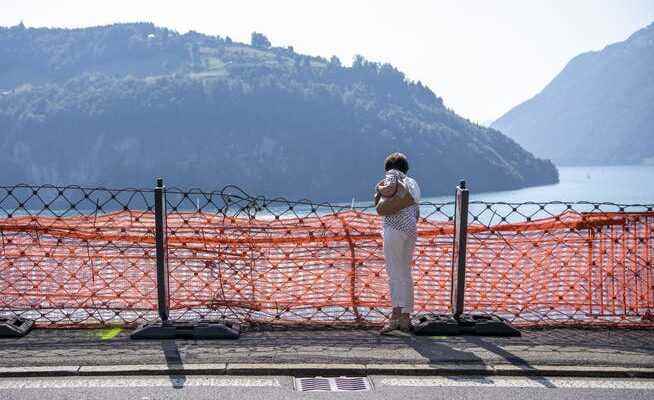Just because it’s banal doesn’t make it wrong: life remains dangerous.
Is there really an abyss behind the barrier? A passer-by visits the accident site on Axenstrasse.
Of course, it is a success story how the Swiss have been trying to protect themselves from the mighty nature in which they live for centuries – how they build up avalanche slopes, how they tunnel under mountains and protect themselves and others from abysses with railings, as they systematically laid a network of hiking trails across the Alps.
What threatens to be lost on this path, however, is the natural awareness of the dangers of nature. Just because it’s banal doesn’t make it wrong: life remains dangerous.
secure paths
In these holiday days, when people go to the Alps, accidents and impending accidents move the country. A car crashed on Axenstrasse, through a railing that was actually too fragile and into Lake Lucerne. Since then, the media has been wondering why the site wasn’t better protected – and why two tunnels that had been planned for a long time weren’t built long ago. As if accidents couldn’t happen in tunnels as well.
In the abysmal rock arena of the Creux du Van, the Grand Canyon of Switzerland, a woman has thrown her children and herself to her death. It is not easy to accept that such tragic events can happen. However, the largely unsecured massif soon became the focus of media attention. In a survey of hikers made by “Blick”, someone said: “It’s crazy that people can just go to the abyss here.” But the total length of the sheer cliffs is four kilometers. Abysses cannot simply be heaped up at random, neither topographically nor humanly.
High above the Seealpsee, in the Alpstein, a hiker and a hiker fell over a rock face on a steep mountain path and died. The local police recently said about this trail that people often overlook “that it is not an ordinary hiking trail”. After the crashes, you want to check whether the path can be made even safer.
At some point, however, we will reach our limits with barriers, barriers and warning signs. Or they are reversed: the stronger the sense of security spreads in society (and to emphasize it again: that is progress), and the stronger the efforts are to signpost as many dangers as possible, the weaker the inner feeling seems to be for dangers. Security will always remain fragile, there is no such thing as absolute security anyway. Not even in tunnels, not even on so-called secured hiking trails.
lock mountains
In the Valais mountains, the danger of falling rocks has increased with the temperatures. The Zermatt mountain guides have therefore decided not to go up the Matterhorn at the moment. The well-known ski acrobat and mountain guide Art Furrer would go even further. In the “Walliser Bote” he demanded on Tuesday: “We must be able to block mountains like the Matterhorn.” He calls for a corresponding change in the law.
As realistic as the mountain guides’ assessment is, Art Furrer’s demand is just as unrealistic. Dangers can be named, they can be anticipated, they can be avoided, but they cannot be locked away. The Valais mountain guide Richard Lehner, who runs the Monte Rosa hut, said a decisive sentence in an interview in the NZZ last week: “If you were to close entire mountains, that also means that you would open them again when they were safe are.”
We may be able to have our car, our mountain bike, our hiking equipment fully comprehensively insured, but not ourselves.
